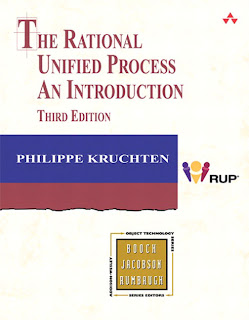 Book Description
Book DescriptionThe Rational Unified Process: An Introduction is a good overview of Rational's prescription for whole-project health. The process is unified as in "Unified Field Theory." Thesis, Antithesis, and Synthesis, (or Booch, Jacobson, and Rumbaugh, as they are known today) twine in a celestial dance to the Spheres, Rectangles, Clouds, and stray pointers that make up UML and its increasingly ambitious extensions, additions, and heroic leaps of faith.
Rational visualizes the elements and modalities of code and projects in a fashion found compelling by increasing numbers of corporate customers. It's a vision embodied in several software suites, including the eponymous Rational Unified Process, for which this book is designed to serve as the introduction. Face it, you are going to run into Rational on the job. This volume is a good place to get know about it.
The book is not an independent assessment of Rational. Editor Philippe Kruchten is lead architect of the Rational Unified Process product. The thrust is the process of processes, specifically process in software projects, as viewed by Rational and supported by its project-management toolsets. Read more--Jack Woehr, Dr. Dobb's Journal --This text refers to an out of print or unavailable edition of this title.
This concise book offers a quick introduction to the concepts, structure, content, and motivation of the Rational Unified Process--a Web-enabled software engineering process that enhances team productivity and delivers software best practices to all team members. The Rational Unified Process is unique in that it allows development teams to recognize the full benefits of the Unified Modeling Language (UML), software automation, and other industry best practices.
The Rational Unified Process unifies the entire software development team and optimizes the productivity of every team member by putting the collective experience derived from thousands of projects and many industry leaders at your fingertips. With this book as your guide, you will be able to more easily produce, within a predictable schedule and a reasonable budget, the highest-quality software possible. Throughout the book, the author shares his inside knowledge of the process, focusing his coverage on key aspects that are critical to mastering this proven approach to software development.
This Second Edition has been updated to match and reflect the contents of the latest version of the Rational Unified Process. In particular, RUP 2000 offers:
More guidance for e-development Roadmaps that provide overviews of how to apply the process to a wide variety of projects and technologies Expanded analysis of testing, spanning the entire product lifecycle Improved coverage of application interface design--especially as it applies to developing effective web applications Enhanced details for developing real-time and reactive systems Insights into designing systems using patterns and frameworks --This text refers to an out of print or unavailable edition of this title.
Book Info
(Pearson Education) A concise text offering an introduction to the concepts, structure, and content of the Rational Unified Process, explaining all of the benefits it offers. Benefits discussed include more guidance for e-development, expanded analysis of testing, and insights into designing systems. Softcover. DLC: Computer software--Development. --This text refers to an out of print or unavailable edition of this title.
From the Back Cover
The Rational Unified Process, Third Edition, is a concise introduction to IBM's Web-enabled software engineering process. Rational Unified Process®, or RUP®, Lead Architect Philippe Kruchten quickly and clearly describes the concepts, structure, content, and motivation that are central to the RUP. Readers will learn how this approach to software development can be used to produce high-quality software, on schedule and on budget, using the Unified Modeling Language (UML), software automation, and other industry best practices.
The RUP unifies the entire software development team and optimizes the productivity of each team member by bringing them the experience of industry leaders and lessons learned from thousands of projects. It provides detailed and practical guidance through all phases of the software development life cycle, but it is not inflexible. The RUP can be tailored to suit a wide variety of projects and organizations.
This new edition has been updated to reflect all the changes integrated into the latest version of the Rational Unified Process--RUP 2003. It includes a four-color poster that lists key RUP elements: disciplines, workflows, artifacts, phases, and milestones.
RUP 2003 also offers
# The RUP Builder with enhanced configurability, process views, and three base configurations.
# MyRUP, enabling personalized views of the RUP configuration.
# Additions to the Rational Process Workbench, used to define process components, perform modifications to the RUP, and create process plugins.
# The introduction of a separate Process Engineering Process offering guidance on adapting the RUP, creating plugins, and deploying the RUP.
The Rational Unified Process, Third Edition, is a reliable introduction to the Rational Unified Process that will serve project managers and software professionals alike.
http://rapidshare.com/files/3011773/An_Introduction3.rar
Password: www.AvaxHome.ru



0 comments:
Post a Comment